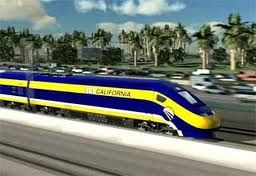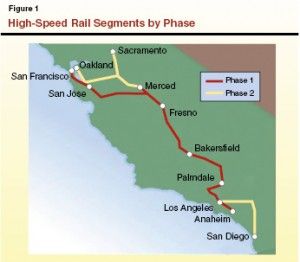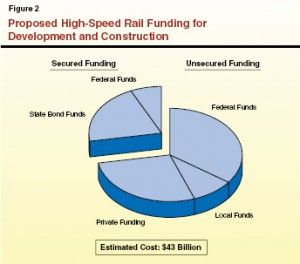High-Speed Platinum Contracts
by CalWatchdog Staff | January 13, 2012 8:58 am
JAN. 13, 2012
By KATY GRIMES
It’s like a runaway train pushing a side a cow on the tracks. Controversy over the $98.5 billion-dollar-and-growing price tag? Move aside! The California High-Speed Rail Authority held a seemingly “regular” monthly meeting in Los Angeles on Thursday. But the real story was a brewing controversy about an obscure, costly proposal for the high-profile project, which could add to the already skyrocketing costs to build a High-Speed Rail system in the state.
 [1]
[1]
AB 1254[2], authored by Assemblyman Mike Davis, D-Los Angeles, would require that a minimum of 25 percent of the workforce used at each worksite be from the local workforce. And it would require that a minimum of 25 percent of the aggregate dollar amount of contracts awarded be subject to project labor agreements.
Forget the free market and competitive bidding. High-Speed Rail could be constructed using more expensive, “platinum” union contractors, if AB 1254 is passed. Prevailing wages and union labor contracts could become the roadblock to non-union private sector contractors working on high-speed rail construction.
Status of High-Speed Rail Today
The recently passed SB 52[3], known as “The Jobs and Economic Improvement Through Environmental Leadership Act of 2011,” establishes California Environmental Quality Act[4] permit streamlining. But it does so only for projects costing $100 million or more. And it requires high wages — specifically, prevailing wages as determined by the state of California. Prevailing wages are paid at union-wage scales instead of current market-based wages determined by what the market will bear.
 [5]
[5]
“What may have once seemed a worthy project has been exposed as a high-speed marketing charade to the sophisticated voters of California,” Assemblywoman Diane Harkey, R-Dana Point, said at a press conference this week. At the conference, she introduced legislation to halt state debt funding of the High-Speed Rail project. “The Legislature would be wise to do their job and stop the financial and real property carnage.”
As reasons enough to pull the plug on the project, Harkey cited a lack of future federal funding and a lack of oversight, accountability and inconsistency in route and planning. “Our governor is asking for long-term increases, while recommending cuts to education and public safety. This one project has the potential to double our state’s debt and become a huge future drain on our state’s budget,” Harkey added. “California does not need a shiny new heavily subsidized toy with no confirmed ridership.”
In fact, California’s existing rail and roadway infrastructure is in need of attention and funding. But that’s not part of the high-speed spending plan.
Many rail followers anticipated that the board members of the California High-Speed Rail Authority were planning on discussing and supporting Assembly Bill 1254[6], the new bill that requires the California High-Speed Rail Authority to perform at least 25 percent of its contracts under a Project Labor Agreement. But that issue was pulled from the agenda the evening before the Thursday meeting.
How Did PLAs Become Part of the Deal?
“The State Building Trades made a strategic blunder in exposing their intent to force construction contractors to sign a PLA by having this bill introduced,” said Kevin Dayton, government affairs director for the Association of Builders and Contractors[7], a non-union contractors’ association. “It provides specific, explicit documentation proving the PLA plot, when HSR board member Balgenorth could have imposed the PLA in a sneaky, underhanded way through manipulating the design-build contractor for the first phase.”
Dayton explained that Balgenorth wrote an opinion piece[8] in the November 27, 2011 Bakersfield Californian newspaper promoting construction of the state’s proposed $98.5 billion High-Speed Rail as a better alternative to the construction and modernization of freeways and airports. Balgenorth wrote[9], “High-speed rail is the only viable means of making sure our transportation infrastructure can meet our growing demand. Continuing to build more and more freeways and airports would be more expensive, more environmentally damaging, and less efficient for moving millions more Californians up and down our state.”
Dayton asked recently in a story[10] for The Truth About PLAs[11], “What would lead Balgenorth to make such a bold public assertion? Is it possible he has greater wisdom and foresight than the average Californian about getting a speedier ride from Madera to Corcoran after 2017?”
Balgenorth, head of the California State Building and Construction Trades Council, AFL-CIO[12], is also on the High-Speed Rail Board of Directors — quite a coup, according to Dayton.
In March 2011, the Democrat-controlled State Senate Rules Committee [13]appointed Balgenorth to a vacant seat on the California High-Speed Rail Authority Board of Directors[14]. Dayton said that Russ Burns, the business manager for Operating Engineers Local No. 3, also serves on the nine-member board.
Dayton said that likely construction contract scenarios include the California High-Speed Rail Authority’s Board of Directors[15]’ approval of a resolution requiring its contractors to sign a Project Labor Agreement. Or political pressure could be exerted behind the scenes to convince the prime contractor to negotiate and sign a PLA, without any explicit direction from the High-Speed Rail Authority. Either scenario will cost taxpayers significantly more than competitive bids would cost.
Californians Would Reject Rail Bond
In 2008, voters narrowly approved Proposition 1A[16], the “Safe, Reliable High-Speed Passenger Train Bond Act for the 21st Century.” It green-lighted the issuance of $9.95 billion in general obligation bonds for the project. A recent Field Poll [17]found that, by a nearly two-to-one margin, Californians would reject the $9.95 billion bond if again presented with the choice at the ballot box.
 [18]
[18]
The fiscal estimate provided by the California Legislative Analyst’s Office[19] said, “State costs of about $19.4 billion, assuming 30 years to pay off both principal ($9.95 billion) and interest ($9.5 billion) costs of the bonds. Payments of about $647 million per year.
“When constructed, additional unknown costs, probably in excess of $1 billion a year, to operate and maintain a high-speed train system. The costs would be at least partially, and potentially fully, offset by passenger fare revenues, depending on ridership.”
In a 2011 report[20] on the High-Speed Rail plans[21], the California Legislative Analyst’s Office[19] recommended that, because of numerous problems, the first segment of the train should be built somewhere other than Bakersfield to Fresno. It added that, “based on our analysis, other segments could provide greater benefit to the state’s overall transportation system even if the rest of the high-speed rail system were not completed.”
The LAO report also said [22]that the project has “governance problems” and that control of the project should be transferred from California’s High-Speed Rail Authority to the California Department of Transportation.
But none of the dire warnings has put an halt to the rail project. Instead, it appears that many in the state Legislature, as well as Gov. Jerry Brown, are insisting that High-Speed Rail receive full taxpayer funding and support.
At a time when California is nearly bankrupt and facing crushing deficits for generations to come, Harkey said that funding such a large “non-priority project” would likely divert funds from local transportation, and starve other necessary state programs.
But critics insist that the High-Speed Rail “boondoggle” has become a full-blown train wreck, as California faces an actual cash deficit of $21 billion[23], amounting to nearly one-quarter of the total $88.5 billion state budget. And those numbers come from the State Controller[24].
- [Image]: http://www.calwatchdog.com/wp-content/uploads/2011/03/California-High-Speed-Rail.jpg
- AB 1254: http://www.aroundthecapitol.com/Bills/AB_1254/20112012/
- SB 52: http://www.leginfo.ca.gov/pub/11-12/bill/sen/sb_0051-0100/sb_52_bill_20120104_amended_sen_v98.pdf
- California Environmental Quality Act: http://ceres.ca.gov/ceqa/
- [Image]: http://www.calwatchdog.com/wp-content/uploads/2012/01/ET_HSR_Map_fmt.jpeg
- Assembly Bill 1254: http://www.leginfo.ca.gov/pub/11-12/bill/asm/ab_1251-1300/ab_1254_bill_20120104_amended_asm_v98.pdf
- Association of Builders and Contractors: http://www.abc.org/
- an opinion piece: http://www.bakersfield.com/opinion/forum/x986931101/Airport-highway-expansion-impractical-HSR-better-option?utm_source=widget_60&utm_medium=summary_entries_teaser_widget&utm_campaign=synapse
- wrote: http://www.bakersfield.com/opinion/forum/x986931101/Airport-highway-expansion-impractical-HSR-better-option?utm_source=widget_60&utm_medium=summary_entries_teaser_widget&utm_campaign=synapse
- story: http://thetruthaboutplas.com/2011/01/12/california’s-top-construction-union-officials-love-the-state’s-100-billion-high-speed-rail-project/
- The Truth About PLAs: http://thetruthaboutplas.com/2011/01/12/california’s-top-construction-union-officials-love-the-state’s-100-billion-high-speed-rail-project/
- California State Building and Construction Trades Council, AFL-CIO: http://www.sbctc.org/
- State Senate Rules Committee : http://srul.senate.ca.gov/
- California High-Speed Rail Authority Board of Directors: http://www.cahighspeedrail.ca.gov/monthly_brdmtg.aspx
- California High-Speed Rail Authority’s Board of Directors: http://www.cahighspeedrail.ca.gov/monthly_brdmtg.aspx
- Proposition 1A: http://ballotpedia.org/wiki/index.php/California_Proposition_1A,_High-Speed_Rail_Act_(2008)
- Field Poll : http://www.field.com/fieldpollonline/subscribers/Rls2400.pdf
- [Image]: http://www.calwatchdog.com/wp-content/uploads/2012/01/ET_HSR_Funding-Pie_fmt.jpeg
- California Legislative Analyst’s Office: http://ballotpedia.org/wiki/index.php/California_Legislative_Analyst%27s_Office
- 2011 report: http://www.lao.ca.gov/reports/2011/trns/high_speed_rail/high_speed_rail_051011.aspx
- plans: http://www.lao.ca.gov/reports/2011/trns/high_speed_rail/high_speed_rail_051011.aspx
- LAO report also said : http://www.lao.ca.gov/reports/2011/trns/high_speed_rail/high_speed_rail_051011.aspx
- actual cash deficit of $21 billion: http://www.calwatchdog.com/2012/01/12/ca-running-massive-cash-deficit/
- State Controller: http://sco.ca.gov/ard_state_cash_summaries.html
Source URL: https://calwatchdog.com/2012/01/13/high-speed-platinum-contracts/